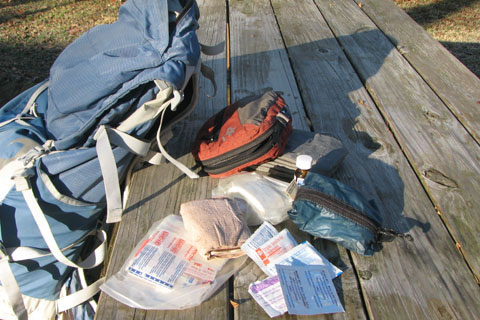| 322 | Hiking Skills - The Ten Essentials - First Aid | 2010-12-20 |

I hardly ever need or use the first aid kit, but it is light enough and small enough that it is easy to pack. Over the years my kit has been refined. Items are added and others taken away. If I am traveling light and fast, the kit will be more spartan than if I am doing a multi-day mountaineering trip.
The ever changing kit lives in the bottom of my pack as an essential. I never have to worry about whether I have a kit, but at times I have had to improvise because I did not restock the provisions.
Contents of my Basic Kit:
- Various bandages - Band-Aid type of different sizes
- Blister relief bandages - Mole skin or others
- Gauze pads - Different sizes
- Wound cleansing towels - Small individually sealed antiseptic towels
- Ointments - Triple Antibiotic
- Rash prevention ointment - Sports Slick or others
- Tape - Small roll of athletic tape
- Elastic bandage - Either the self-adhesive of the ones with clips
- Sam Splint - A lightweight moldable splint, invaluable with leg or arm injuries.
- Pain relief - Ibuprofen or other type medicine
- Gas relief - For the after the freeze dried dinner shock to the stomach
- Allergy Meds - Might not be needed for everyone, but I definitely have issues
- Electrolyte tablets - Prevents cramping
- Other - you would also want to bring specific medicines to meet your needs
And a few suggestions...
- If you don't have a first aid kit, buy a basic one and then start customizing it. There are many kits available from REI Kits to Adventure Medical Kits. I do not see much difference in the contents.
- If you are serious about medical care, a wilderness first aid class is probably more valuable than any kit.
- Don't put things in the kit that you do not know how to use.
- The kit is for first aid, if you need a doctor, then it is time to find one.
- Do pre-trip inventory on the kit and re-supply. It is easy to forget that you used the last medium sized band aid, took the last ibuprofen, etc.
- I keep my medicines separate from my first aid kit. Storing the meds in small plastic bags (available at drug stores) I then store the plastic bags in a small lightweight pouch. I tend to need the medicines (and vitamins) more often than the rest of the kit, so I store it in an easily accessible location - like the top pouch of the pack.
- I store my first aid supplies in a lightweight pouch which also includes basic survival gear. I keep the kit filled with only essentials and leave it in the bottom of my pack.
- I have several first aid kits designed for the particular outing - a trail running kit, mountain biking kit, etc.
- In group hiking (two or more) everyone should carry an individual kit and then one person carry the group kit. The group kit is more comprehensive and it's weight is counted as group gear.
Happy First Aid trails.
Basic First Aid Kits are available from all our affiliates' sites in the right sidebar.
Links to Essentials
